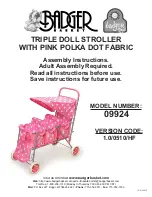
Introduction
This installation guide provides instructions for installation, startup,
and adjustment. To receive a copy of the instruction manual,
contact your local Sales Office or view a copy at www.fisher.com.
For further information refer to: Type Y692 Instruction Manual,
form 5347, D102031X012.
P.E.D. Categories
This product may be used as a safety accessory with pressure
equipment in the following Pressure Equipment Directive categories.
It may also be used out- side of the Pressure Equipment Directive
using sound engineering practice (SEP) per table below. For
information on the current PED revision see Bulletin:
D103053X012
.
ProDuCt sIzE
CatEgory
FluID tyPE
DN 40 and 50 / 1-1/2 and 2 in.
I
1
Specifications
Maximum allowable Inlet Pressure
(1)
10.3 bar / 150 psig or body rating limit
Maximum Control (Casing) Pressure
(1)
1.0 bar / 15 psig
Proof test Pressure
All Pressure Retaining Components have been proof
tested per PED
outlet Pressure ranges
(1)
Light Spring Assembly:
2 to 7 mbar / 1 to 3 in. w.c.,
7 to 26 mbar / 3 to 11 in. w.c., 16 to 86 mbar /
6.5 in. w.c. to 1.2 psig, 0.05 to 0.14 bar / 0.7 to 2 psig and
0.07 to 0.22 bar / 1 to 3.2 psig
Heavy Spring Assembly:
0.14 to 0.38 bar / 2 to 5.5 psig and
0.28 to 0.48 bar / 4 to 7 psig
Maximum operating outlet Pressure to avoid Internal
Part Damage
(1)
0.21 bar / 3 psig above outlet pressure setting
temperature Capabilities
(1)
Nitrile (NBR):
-29 to 82°C / -20 to 180°F
Fluorocarbon (FKM):
-18 to 149°C / 0 to 300°F
Ethylenepropylene (EPDM):
-29 to 135°C / -20 to 275°F
Perfluoroelastomer (FFKM):
-29 to 149°C / -20 to 300°F
Installation
!
WarnIng
Only qualified personnel should install or service a
regulator. Regulators should be installed, operated
and maintained in accordance with international
and applicable codes and regulations and Emerson
Process Management Regulator Technologies Inc.
(Emerson) instructions.
If the regulator vents fluid or a leak develops in the
system, it indicates that service is required. Failure
to take the regulator out of service immediately may
create a hazardous condition.
Personal injury, equipment damage or leakage due
to escaping fluid or bursting of pressure-containing
parts may result if this regulator is overpressured or
is installed where service conditions could exceed
the limits given in the Specifications section or
where conditions exceed any ratings of the adjacent
piping or piping connections.
To avoid such injury or damage, provide pressure-
relieving or pressure-limiting devices (as required
by the appropriate code, regulation or standard) to
prevent service conditions from exceeding limits.
Additionally, physical damage to the regulator could
result in personal injury and property damage due
to escaping fluid. To avoid such injury and damage,
install the regulator in a safe location.
Clean out all pipelines before installation of the regulator and
check to be sure the regulator has not been damaged or has
collected foreign material during shipping. For NPT bodies, apply
pipe compound to the male pipe threads. For flanged bodies, use
suitable line gaskets and approved piping and bolting practices.
Install the regulator in any position desired, unless otherwise
specified, but be sure flow through the body is in the direction
indicated by the arrow on the body.
For proper operation, the regulator must be installed with the spring
case barrel pointed down.
note
It is important that the regulator be installed so that
the vent hole in the spring case is unobstructed at all
times. For outdoor installations, the regulator should
be located away from vehicular traffic and positioned
so that water, ice and other foreign materials cannot
enter the spring case through the vent. Avoid placing
the regulator beneath eaves or downspouts and be
sure it is above the probable snow level.
overpressure Protection
The recommended pressure limitations are stamped on the regulator
nameplate. Some type of overpressure protection is needed if the
actual inlet pressure exceeds the maximum operating outlet pressure
rating. Overpressure protection should also be provided if the
regulator inlet pressure is greater than the safe working pressure of
the downstream equipment.
Regulator operation below the maximum pressure limitations does
not preclude the possibility of damage from external sources or debris
in the line. The regulator should be inspected for damage after any
overpressure condition.
startup
The regulator is factory set at approximately the midpoint of the spring
range or the pressure requested, so an initial adjustment may be
required to give the desired results. With proper installation completed
and relief valves properly adjusted, slowly open the upstream and
downstream shutoff valves.
adjustment
To change the outlet pressure, remove the closing cap or loosen the
locknut and turn the adjusting screw clockwise to increase outlet pressure
or counterclockwise to decrease pressure. Monitor the outlet pressure with
a test gauge during the adjustment. Replace the closing cap or tighten the
locknut to maintain the desired setting.
1. The pressure/temperature limits in this installation guide and any applicable standard or
code limitation should not be exceeded.
Type Y692
Installation Guide
D102031X014
English - November 2016




















